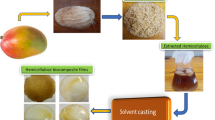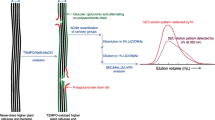Abstract
Hemicelluloses, the second most abundant class of biopolymers, have emerged as an immense renewable resource of biopolymers that are recognized as currently being underutilized. Carboxymethyl carbohydrates are valuable products for thickeners, viscosity control, food additive and others. Hemicellulose isolated from poplar was converted to carboxymethyl hemicellulose using sodium chloroacetate (SCA) and sodium hydroxide (NaOH). The significance of the effects of carboxymethylation conditions in an 80% ethanol/water medium on the degree of substitution (DS) and reaction efficiency (RE) was evaluated using a definitive screening design model. There was strong evidence that the dosage of SCA and NaOH, and temperature have a significant effect on DS. A significant interaction between SCA and NaOH was also statistically confirmed. The RE resulting from the ethanol/water medium was lower than 50%. A higher RE of 72% with a DS 1.08 was achieved in a 90% tert-butyl alcohol/water medium, which was conducted at 85 °C with 120 min, 1.5 mol/mol anhydroxylose unit (AXU) of NaOH and 1.5 mol/mol AXU of SCA. The potential of using hemicellulose and carboxymethyl hemicellulose as materials to produce water-soluble films was evaluated. Due to the increased water solubility, the processing of carboxymethyl hemicellulose in water and the production of films were more facile than with unmodified hemicellulose. All of the films demonstrated significant oxygen barrier characteristics, with low oxygen permeability ranging from 0.28 to 0.55 cm3 µm/(m2 d kPa). The films did not display effective water vapor barrier characteristics, with high water vapor permeability ranging from 4.8 to 6.5 g mm/(m2 d kPa). Carboxymethylation of HC decreased the tensile strength, increased the elongation at break, and decreased the water vapor and oxygen barrier properties of the produced films. Both hemicellulose and carboxymethyl hemicellulose films could offer a bio-based and biodegradable alternative to existing synthetic oxygen barrier materials. The hemicellulose and carboxymethyl hemicellulose materials might be exploited in water-soluble films, washable fruit coating or used in composites or multilayer films in conjunction with hydrophobic layers.
Graphic abstract















Similar content being viewed by others
References
Alekhina M, Mikkonen KS, Alén R, Tenkanen M, Sixta H (2014) Carboxymethylation of alkali extracted xylan for preparation of bio-based packaging films. Carbohydr Polym 100:89–96. https://doi.org/10.1016/j.carbpol.2013.03.048
Alvarez-Vasco C, Zhang X (2013) Alkaline hydrogen peroxide pretreatment of softwood: hemicellulose degradation pathways. Bioresour Technol 150:321–327. https://doi.org/10.1016/j.biortech.2013.10.020
ASTM (2016) Standard test method for water vapor transmission of materials. Compass. https://compass.astm.org/EDIT/html_annot.cgi?E96+16. Accessed 9 May 2019
ASTM (2017) Standard test method for oxygen gas transmission rate through plastic film and sheeting using a coulometric sensor. Compass. https://compass.astm.org/EDIT/html_annot.cgi?D3985+17. Accessed 26 Mar 2019
Aulin C, Gallstedt M, Lindstrom T (2010) Oxygen and oil barrier properties of microfibrillated cellulose films and coatings. Cellulose 17(3):559–574. https://doi.org/10.1007/s10570-009-9393-y
Ayoub A, Venditti RA, Pawlak JJ, Sadeghifar H, Salam A (2013) Development of an acetylation reaction of switchgrass hemicellulose in ionic liquid without catalyst. Ind Crops Prod 44:306–314. https://doi.org/10.1016/j.indcrop.2012.10.036
Bhandari PN, Jones DD, Hanna MA (2012) Carboxymethylation of cellulose using reactive extrusion. Carbohydr Polym 87:2246–2254. https://doi.org/10.1016/j.carbpol.2011.10.056
Broekaert WF, Courtin CM, Verbeke K, Van de Wiele T, Verstraete W, Delcour JA (2011) Prebiotic and other health-related effects of cereal-derived arabinoxylans, arabinoxylan-oligosaccharides, and xylooligosaccharides. Crit Rev Food Sci Nutr 51:178–194. https://doi.org/10.1080/10408390903044768
Broeren MLM (2018) Sustainable bio-based materials—application and evaluation of environmental impact assessment methods. Dissertation, Utrecht University
Buchholz FL, Peppas NA (1994) Superabsorbent polymers: science and technology. American Chemical Society, Washington DC
Chen GG, Qi XM, Guan Y, Peng F, Yao CL, Sun RC (2016) High strength hemicellulose-based nanocomposite film for food packaging applications. ACS Sustain Chem Eng 4:1985–1993. https://doi.org/10.1021/acssuschemeng.5b01252
de Britto D, Assis OB (2009) Thermal degradation of carboxymethylcellulose in different salty forms. Thermochim Acta 494:115–122. https://doi.org/10.1016/j.tca.2009.04.028
de Mattos NR, Colodette JL, de Oliveira CR (2019) Alkaline extraction and carboxymethylation of xylans from corn fiber. Cellulose 26:2177–2189. https://doi.org/10.1007/s10570-018-02236-5
Ebringerová A (2005) Structural diversity and application potential of hemicelluloses. Macromol Symp 232:1–12. https://doi.org/10.1002/masy.200551401
Ebringerová A, Heinze T (2000) Xylan and xylan derivatives—biopolymers with valuable properties. 1. Naturally occurring xylans structures, isolation procedures and properties. Macromol Rapid Commun 21:542–556. https://doi.org/10.1002/1521-3927(20000601)21:9%3c542:AID-MARC542%3e3.0.CO;2-7
Fang J, Fowler P, Tomkinson J, Hill C (2002) Preparation and characterisation of methylated hemicelluloses from wheat straw. Carbohydr Polym 47:285–293. https://doi.org/10.1016/S0144-8617(01)00186-2
Ferrer A, Pal L, Hubbe M (2017) Nanocellulose in packaging: advances in barrier layer technologies. Ind Crops Prod 95:574–582. https://doi.org/10.1016/j.indcrop.2016.11.012
Geng W, Venditti RA, Pawlak JJ, Chang H-m (2018) Effect of delignification on hemicellulose extraction from switchgrass, poplar, and pine and its effect on enzymatic convertibility of cellulose-rich residues. Bioresources 13:4946–4963
Geng W, Venditti RA, Pawlak JJ, De Assis T, Gonzalez RW, Phillips RB, Chang H-m (2019a) Techno-economic analysis of hemicellulose extraction from different types of lignocellulosic feedstocks and strategies for cost optimization. Biofuel Bioprod Biorefin. https://doi.org/10.1002/bbb.2054
Geng W, Narron R, Jiang X, Pawlak JJ, Chang H-m, Park S, Jameel H, Venditti RA (2019b) The influence of lignin content and structure on hemicellulose alkaline extraction for non-wood and hardwood lignocellulosic biomass. Cellulose 26:3219–3230. https://doi.org/10.1007/s10570-019-02261-y
Gírio FM, Fonseca C, Carvalheiro F, Duarte LC, Marques S, Bogel-Łukasik R (2010) Hemicelluloses for fuel ethanol: a review. Bioresour Technol 101:4775–4800. https://doi.org/10.1016/j.biortech.2010.01.088
Gröndahl M, Eriksson L, Gatenholm P (2004) Material properties of plasticized hardwood xylans for potential application as oxygen barrier films. Biomacromolecules 5:1528–1535. https://doi.org/10.1021/bm049925n
Hansen NML, Plackett D (2008) Sustainable films and coatings from hemicelluloses: a review. Biomacromolecules 9:1493–1505. https://doi.org/10.1021/bm800053z
Hartman J, Albertsson A-C, Sjöberg J (2006) Surface-and bulk-modified galactoglucomannan hemicellulose films and film laminates for versatile oxygen barriers. Biomacromolecules 7:1983–1989. https://doi.org/10.1021/bm060129m
Heinze T, Koschella A (2005) Carboxymethyl ethers of cellulose and starch—a review. Macromol Symp 223:13–40. https://doi.org/10.1002/masy.200550502
Konduri MK, Fatehi P (2016) Synthesis and characterization of carboxymethylated xylan and its application as a dispersant. Carbohydr Polym 146:26–35. https://doi.org/10.1016/j.carbpol.2016.03.036
Koshijima T, Timell T, Zinbo M (1965) The number-average molecular weight of native hardwood xylans. J Polym Sci Polym 11:265–279. https://doi.org/10.1002/polc.5070110119
Li W, Sun B, Wu P (2009) Study on hydrogen bonds of carboxymethyl cellulose sodium film with two-dimensional correlation infrared spectroscopy. Carbohydr Polym 78:454–461. https://doi.org/10.1016/j.carbpol.2009.05.002
Mendes FR, Bastos MS, Mendes LG, Silva AR, Sousa FD, Monteiro-Moreira AC, Cheng HN, Biswas A, Moreira RA (2017) Preparation and evaluation of hemicellulose films and their blends. Food Hydrocoll 70:181–190. https://doi.org/10.1016/j.foodhyd.2017.03.037
Mikkonen KS, Schmidt J, Vesterinen AH, Tenkanen M (2013) Crosslinking with ammonium zirconium carbonate improves the formation and properties of spruce galactoglucomannan films. J Mater Sci 48:4205–4213. https://doi.org/10.1007/s10853-013-7233-9
Mudgil D, Barak S (2013) Composition, properties and health benefits of indigestible carbohydrate polymers as dietary fiber: a review. Int J Biol Macromol 61:1–6. https://doi.org/10.1016/j.ijbiomac.2013.06.044
Paszner L (1988) Salt catalyzed wood bonding with hemicellulose. Holzforschung 42:11–20. https://doi.org/10.1515/hfsg.1988.42.1.11
Peng X, Ren J, Zhong L, Cao X, Sun R (2011) Microwave-induced synthesis of carboxymethyl hemicelluloses and their rheological properties. J Agric Food Chem 59:570–576. https://doi.org/10.1021/jf1036239
Péroval C, Debeaufort F, Despré D, Voilley A (2002) Edible arabinoxylan-based films. 1. Effects of lipid type on water vapor permeability, film structure, and other physical characteristics. J Agric Food Chem 50:3977–3983. https://doi.org/10.1021/jf0116449
Polyprint (2019) Poly print: oxygen transmission rate. https://www.polyprint.com/flexographic-otr.htm. Accessed 9 May 2019
Rachtanapun P, Tongdeesoontorn W (2009) Effect of glycerol concentration on sorption isotherms and water vapour permeability of carboxymethyl cellulose films from waste of mulberry paper. Asian J Food Agro Ind 2:478–488
Ren J, Sun R, Peng F (2008) Carboxymethylation of hemicelluloses isolated from sugarcane bagasse. Polym Degrad Stab 93:786–793. https://doi.org/10.1016/j.polymdegradstab.2008.01.011
Saberi B, Vuong QV, Chockchaisawasdee S, Golding JB, Scarlett CJ, Stathopoulos CE (2016) Mechanical and physical properties of pea starch edible films in the presence of glycerol. J Food Process Preserv 40:1339–1351. https://doi.org/10.1111/jfpp.12719
Šimkovic I, Kelnar I, Uhliariková I, Mendichi R, Mandalika A, Elder T (2014) Carboxymethylated-, hydroxypropylsulfonated-and quaternized xylan derivative films. Carbohydr Polym 110:464–471. https://doi.org/10.1016/j.carbpol.2014.04.055
Sluiter A, Hames B, Ruiz R, Scarlata C, Sluiter J, Templeton D, Crocker D (2008) Determination of structural carbohydrates and lignin in biomass. Lab Anal Proced 1617:1–16
Sousa S, Ramos A, Evtuguin DV, Gamelas JA (2016) Xylan and xylan derivatives—their performance in bio-based films and effect of glycerol addition. Ind Crops Prod 94:682–689. https://doi.org/10.1016/j.indcrop.2016.09.031
Sugama T, Pyatina T (2015) Effect of sodium carboxymethyl celluloses on water-catalyzed self-degradation of 200 °C-heated alkali-activated cement. Cem Concr Compos 55:281–289. https://doi.org/10.1016/j.cemconcomp.2014.09.015
Sun R, Fang J, Tomkinson J, Jones G (1999) Acetylation of wheat straw hemicelluloses in N,N-dimethylacetamide/LiCl solvent system. Ind Crops Prod 10:209–218. https://doi.org/10.1016/S0926-6690(99)00025-4
Sun R, Fang J, Tomkinson J, Geng Z, Liu J (2001) Fractional isolation, physico-chemical characterization and homogeneous esterification of hemicelluloses from fast-growing poplar wood. Carbohydr Polym 44:29–39. https://doi.org/10.1016/S0144-8617(00)00196-X
Sun X, Tyagi P, Agate S, Lucia L, McCord M, Pal L (2019) Unique thermo-responsivity and tunable optical performance of poly(N-isopropylacrylamide)-cellulose nanocrystal hydrogel films. Carbohydr Polym 208:495–503. https://doi.org/10.1016/j.carbpol.2018.12.067
Thakur VK, Thakur MK (2015) Handbook of polymers for pharmaceutical technologies. Wiley, Hoboken
Tongdeesoontorn W, Mauer L, Wongruong S, Rachtanapun P (2009) Water vapour permeability and sorption isotherms of cassava starch based films blended with gelatin and carboxymethyl cellulose. Asian J Food Agro Ind 2:501–514
Wang L (2015) Properties of flexible films made of hemicellulose. Dissertation, Michigan State University
Xu C, Eckerman C, Smeds A, Reunanen M, Eklund PC, Sjöholm R, Willför S (2011) Carboxymethylated spruce galactoglucomannans: preparation, characterisation, dispersion stability, water-in-oil emulsion stability, and sorption on cellulose surface. Nordic Pulp Pap Res J 26:1–12
Yeasmin MS, Mondal MIH (2015) Synthesis of highly substituted carboxymethyl cellulose depending on cellulose particle size. Int J Biol Macromol 80:725–731. https://doi.org/10.1016/j.ijbiomac.2015.07.040
Young RJ, Lovell PA (2011) Introduction to polymers. CRC Press, Boca Raton
Zohuriaan M, Shokrolahi F (2004) Thermal studies on natural and modified gums. Polym Test 23:575–579. https://doi.org/10.1016/j.polymertesting.2003.11.001
Acknowledgments
This research was supported by the Southeastern Sun Grant Regional Program of the USDA-NIFA program (Grant Number 2013-38502-21423).
Author information
Authors and Affiliations
Corresponding author
Additional information
Publisher's Note
Springer Nature remains neutral with regard to jurisdictional claims in published maps and institutional affiliations.
Rights and permissions
About this article
Cite this article
Geng, W., Venditti, R.A., Pawlak, J.J. et al. Carboxymethylation of hemicellulose isolated from poplar (Populus grandidentata) and its potential in water-soluble oxygen barrier films. Cellulose 27, 3359–3377 (2020). https://doi.org/10.1007/s10570-020-02993-2
Received:
Accepted:
Published:
Issue Date:
DOI: https://doi.org/10.1007/s10570-020-02993-2




